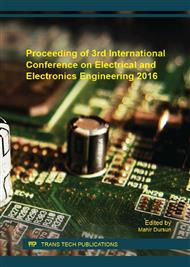p.63
p.71
p.77
p.82
p.88
p.95
p.100
p.105
p.112
Characteristic Evaluation of Multiple Layers Microwave Absorber Coated with Biomass Composite
Abstract:
Radiation Absorbing Material (RAM) is used to absorb radiations of electromagnetic wave surrounding us. Thus, the multiple layers’ microwave absorber using biomass composite materials could be one of the solutions to address the problem. In order to effectively absorb the radiation of electromagnetic wave, the multiple layers’ absorber is characterized to optimize the performance of the absorber. The characterization is made by varying biomass composite material contents, thickness and other possible considerations. CST Microwave Studio software is first used to design and simulate the multiple layers’ absorber to estimate its performance. Development of multiple layers’ prototype is carried out to test its performance at free space environment. Free space dielectric measurement method is used to determine the value of multiple layers’ absorber dielectric. The dielectric value is then used in CST software in order to make the simulation more precise. Free space arch which is connected to Agilent Analyzer is used to measure absorption of multiple layers’ microwave absorber.
Info:
Periodical:
Pages:
88-92
Citation:
Online since:
August 2016
Keywords:
Price:
Сopyright:
© 2016 Trans Tech Publications Ltd. All Rights Reserved
Share:
Citation:


